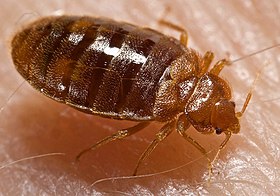利用者:Mr. Ibrahem/1
| Bed bugs | |
|---|---|
| 別称 | Cimicosis, bed bug bites, bedbugs, bed bug infestation |
 | |
| An adult bed bug (Cimex lectularius) with the typical flattened oval shape | |
| 概要 | |
| 診療科 | Family medicine, dermatology |
| 症状 | None to prominent blisters, itchy[1][2] |
| 発症時期 | Minutes to days after the bite[2] |
| 原因 | Cimex (primarily Cimex lectularius and Cimex hemipterus)[3] |
| 危険因子 | Travel, second-hand furnishings[4] |
| 診断法 | Based on finding bed bugs and symptoms[5] |
| 鑑別 | Allergic reaction, scabies, dermatitis herpetiformis[2] |
| 使用する医薬品 | Antihistamines, corticosteroids[2] |
| 治療 | Symptomatic, bed bug eradication[2] |
| 頻度 | Relatively common[6] |
| 分類および外部参照情報 | |
トコジラミは、通常夜間に人間の血を吸う昆虫の一種です。 [7]彼らの咬傷は、皮膚の発疹、心理的影響、アレルギー症状など、さまざまな健康への影響を引き起こす可能性があります。 [5]トコジラミに刺されると、目に見えない程度の発赤から小さな部分の発赤、目立つ水疱まで、さまざまな皮膚の変化が生じる可能性があります。 [1] [2]症状が現れるまでに数分から数日かかることがあり、通常はかゆみを伴います。 [2]人によっては疲労感や発熱を感じることもあります。 [2]典型的には、体の覆われていない部分が侵され、3回連続して刺されることが多い。 [2]トコジラミの咬傷によって感染症が伝染することは知られていない。 [5] [7]合併症としては、まれに皮膚の壊死や血管炎などが起こることがある。 [2]
トコジラミによる刺咬は、主に熱帯地方に生息するCimex属の昆虫2種、 Cimex lectularius (一般的なトコジラミ)とCimex hemipterusによって引き起こされます。 [3]サイズは1から7まであります mm。 [7]近くの場所を這って移動したり、個人の持ち物の中に入り込んで感染が広がります。 [2]害虫の発生は衛生状態の悪さが原因であることは稀ですが、人口密度の高い地域ではより一般的です。 [2] [8]診断にはバグの発見とそれに伴う症状の発生の両方が含まれます。 [5]トコジラミは、マットレスの縫い目や壁の割れ目など、暗くて隠れた場所で多くの時間を過ごします。 [2]
治療は症状に向けられる。 [2]トコジラミは餌を食べなくても1年ほど生きられるため、家からトコジラミを駆除するのは困難な場合が多い。 [2]住宅では繰り返し治療が必要になる場合があります。 [2]これらの治療法には、部屋を50 °C (122 °F)に加熱することが含まれる。90分以上以上の高温環境での作業、頻繁な掃除機がけ、高温での衣類の洗濯、さまざまな殺虫剤の使用などが挙げられます。 [2]
トコジラミは地球上のあらゆる地域で発生します。 [7] 1990年代以降、寄生虫の侵入率は比較的一般的であり、増加傾向にある。 [3] [4] [6]この増加の正確な原因は不明であるが、人間の旅行の増加、中古家具の交換頻度の増加、他の害虫の駆除への重点的な取り組み、殺虫剤に対する耐性の増加などが考えられる。 [4]トコジラミは何千年も前から人間の寄生虫として知られています。 [2]
参考文献
[編集]- ^ a b James, William D.構文エラー:「etal」を認識できません。 (2006). Andrews' Diseases of the Skin: clinical Dermatology. Saunders Elsevier. p. 446. ISBN 978-0-7216-2921-6
- ^ a b c d e f g h i j k l m n o p q r Ibrahim, O; Syed, UM; Tomecki, KJ (March 2017). “Bedbugs: Helping your patient through an infestation.”. Cleveland Clinic Journal of Medicine 84 (3): 207–211. doi:10.3949/ccjm.84a.15024. PMID 28322676.
- ^ a b c Jerome Goddard; Richard deShazo (2009). “Bed bugs (Cimex lectularius) and clinical consequences of their bites”. Journal of the American Medical Association 301 (13): 1358–1366. doi:10.1001/jama.2009.405. PMID 19336711.
- ^ a b c “Bedbugs”. Dermatol Ther 22 (4): 347–52. (2009). doi:10.1111/j.1529-8019.2009.01246.x. PMID 19580578.
- ^ a b c d “Bed bugs – What the GP needs to know”. Aust Fam Physician 38 (11): 880–4. (November 2009). PMID 19893834.
- ^ a b Doggett, SL; Dwyer, DE; Peñas, PF; Russell, RC (January 2012). “Bed bugs: clinical relevance and control options.”. Clinical Microbiology Reviews 25 (1): 164–92. doi:10.1128/CMR.05015-11. PMC 3255965. PMID 22232375.
- ^ a b c d “Bed Bugs FAQs”. Centers for Disease Control and Prevention (2 May 2017). 22 September 2018時点のオリジナルよりアーカイブ。2 October 2018閲覧。
- ^ “JAMA patient page. Bed bugs”. JAMA 301 (13): 1398. (April 2009). doi:10.1001/jama.301.13.1398. PMID 19336718.
